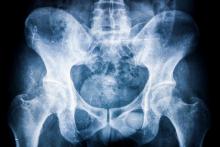A new study rebuts the conventional rheumatology wisdom about ankylosing spondylitis (AS) by reporting that actually there’s no gender gap in the prevalence of the disease. Researchers found no statistically significant difference in rates between men and women based on an analysis of military medical records.
“Our findings challenge the widely held belief that AS in the U.S. occurs substantially more frequently in males than females,” the study authors, led by data scientist D. Alan Nelson, PhD, of Stanford (Calif.) University, wrote in a study published Aug. 30 in Arthritis Care & Research.
The researchers launched the study to fill a gap in knowledge regarding case rates by gender. “The incidence of AS in the U.S. has been understudied and incompletely characterized,” they wrote.
Even though AS is fairly common, affecting an estimated 1% of the American adult population (2.5 million people), only one published population study has examined rates by gender in the United States. That study tracked cases in Minnesota’s Olmsted County during 1980-2009 and found that the ratio of cases in men vs. women was 3.8:1, which was “consistent with more recent estimates” at the time.
However, the population in that study in 1980 was 100% White, the authors of the new study note. A Canadian study that tracked an Ontario population from 1995 to 2010, meanwhile, suggested that AS rates among women were rising and the gender gap was shrinking. AS rates as a whole also nearly tripled, possibly because of more awareness.
For the new study, researchers retrospectively tracked 728,556 members of the U.S. military who underwent guideline-directed screening for back pain during 2014-2017. The study population was about 68% White, 22% Black, 5% Asian or Pacific Islander, and the remainder were other races or unknown. About 85% were male.
The subjects were monitored for a mean of 2.21 years, and 438 (0.06%) were diagnosed with AS at least once over that period.
The researchers found that the AS rates among males vs. females were similar (incidence rate ratio, 1.16; P = .23; adjusted odds ratio, 0.79; 95% confidence interval, 0.61-1.02; P = .072).
The researchers also found that Whites were more likely to develop AS than Blacks (aOR, 1.39; 95% CI, 1.01-1.66; P = .04).
The risk of AS increased with age, the researchers reported, with the odds growing sevenfold in the 45-and-older population vs. the under-24 population (aOR, 7.3; 95% CI, 5.7-10.3; P < .001).
The researchers noted that their study examined a more diverse population than the earlier Minnesota study. It’s also possible that the results of the two studies differed because of differences in definitions of AS diagnosis or imprecision in diagnosis codes, they wrote.
The researchers added that “the finding of a 1.21 male-female prevalence ratio of AS in the Canadian Ontario study was also generally consistent with our findings. Similar to our study population, the Canadian population was racially more diverse than the Olmsted study population at the times of both studies.”
Some limitations of the study include the fact that the military population is not a random sample and may have low rates of AS. “It is highly likely that most clinically evident cases of AS would have been screened out prior to enrollment in the military service,” they wrote. “Differences between military service members and the general population may explain why we observed a different association between AS incidence and age in comparison to that reported by prior studies. The increasing risk of AS with adult age that we observed could reflect selective discharge patterns related to very early symptoms of AS in this population.”
The study was funded in part by a grant from the Spondylitis Association of America. No information about potential conflicts of interest was provided in the manuscript.


